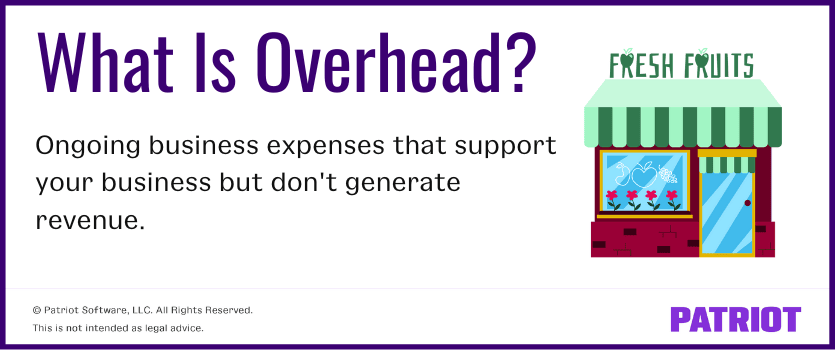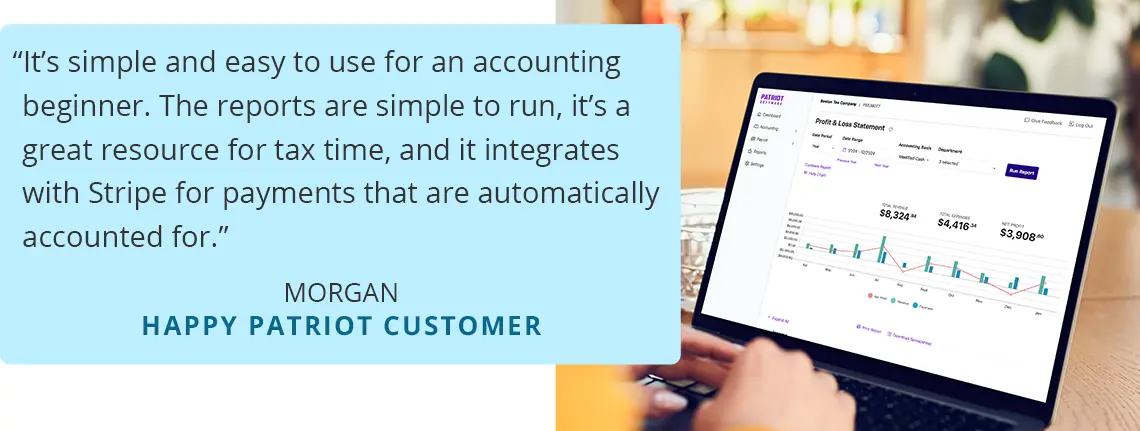If you run a small business, you have overhead expenses. Overhead cost is a necessary part of doing business. Overhead costs won’t disappear, and you can’t ignore them either. But, you may be able to reduce them. What is overhead? Read on to get the scoop on business overhead.
What is overhead cost?
Overhead costs are ongoing, indirect expenses needed to run a business. As an indirect cost, overhead doesn’t directly help your business generate revenue. You have to pay overhead costs no matter what, even if business is slow or you’re losing money. Direct costs, on the other hand, are expenses tied directly to the creation of a product or service (e.g., labor wages or manufacturing materials).
Pop quiz: Paying bills to keep the lights on? That’s both an indirect cost and business overhead. Paying manufacturing costs for a product? That’s a direct cost and isn’t considered overhead.
What’s the difference between overhead costs and G&A?
Overhead costs are often part of your general and administrative costs (G&A). Here’s a quick breakdown of the costs included in G&A expenses.
G&A can cover general expenses like:
- Rent
- Supplies
- Utilities
G&A also covers administrative expenses like:
- Management and administrative salaries
- Consulting expenses
See the difference between general and administrative? Overhead costs are always part of the general expenses in G&A (e.g., rent, supplies, and utilities). But G&A isn’t always overhead, like with expenses for management salaries. Keep in mind that management and administrative salaries are also indirect expenses. They don’t help you manufacture a product or service, but are necessary for your business to continue operating.

Types of overhead costs
It doesn’t matter how big or small a business is. All companies pay overhead. The costs and types of overhead can change depending on the business, the industry, or because the business is entirely online. Still wondering, What are overhead costs? To better understand overhead costs, we can divide them into three categories.
There are three types of overhead expenses you should know about:
- Fixed
- Variable
- Semi-variable
1. Fixed overhead costs
Fixed overhead costs are the same each month, regardless of how your business is doing. Increases or decreases in revenue or production don’t affect fixed overhead costs.
Fixed overhead costs can include:
- Rent or mortgage payments
- Insurance
- Property taxes
- Depreciation of assets
So what does this look like for your business? Let’s look at an example. A tree trimming service, Out on a Limb, Ltd, rents a building for $1,000 a month. In August, Out on a Limb made $4,000 from their tree trimming services. In September (a busy month), the company earned $10,000 from new contracts. Even though Out on a Limb made more money in September, the company paid the same amount in rent for both months because rent is a fixed overhead cost.
Variable overhead costs
Variable overhead costs change from month to month. What does that change look like? Some variable costs you’ll pay one month, but not the next. And, the amount of variable costs may fluctuate.
Variable costs can include:
- Shipping
- Building maintenance
- Office supplies
For example, because of a supply chain shortage, the coffee shop “Thanks A-Latte,” spent $300 more on paper cups this year than last year. The supply chain shortage made the cost of paper cups and shipping increase year-over-year. Because the price of their paper cups is variable, Thanks A-Latte couldn’t plan for this increase, and they don’t know if or when prices may go down.
Don’t forget that variable costs may happen one month but not the next. If Thank A-Latte wants to save money on cups next month, they could reduce their order or forego the order altogether, asking customers to bring in a cup from home. Thanks A-Latte can choose to reduce or skip this type of overhead expense because it’s a variable cost.
Semi-variable costs
Semi-variable costs occur each month, but the amount may vary from month to month. In other words, you can depend on variable costs to happen on time, but the amount may be different each time you pay.
Semi-variable costs can include:
- Utilities
- Fuel
- Repairs
For instance, Royal Flush, a plumbing company, usually spends anywhere from $1,000 to $1,700 on gas each month for their three business vans. But during the recent increase in gas prices, their gas bill broke $2,500 for August. While Royal Flush expected to spend money on fuel, they couldn’t predict what that bill would be because fuel is a semi-variable expense.
Why should you understand overhead costs?
Knowing about overhead costs is one thing. Truly understanding them is another. So, why should you understand your overhead costs? There are several benefits to understanding your business’s overhead costs.
When you understand your business overhead, you can raise prices to help generate revenue or reduce overhead costs to keep money in the bank. Keep in mind that this isn’t an either/or scenario. To protect your bottom line, you can raise prices and reduce overhead costs at the same time.
Raising prices
One way to deal with increasing overhead costs is by raising the prices of your products or services. To do this, factor your overhead costs into the total cost of running your business, and you can find out how much money you need to make a profit.
Let’s see how this works in action by taking another look at Out on a Limb, Ltd. Out on a Limb knows that some months are slower than others. Recent increases in gasoline have also cut into their profits. To make ends meet, the company decides to increase the price of its services to cover fluctuating monthly profits and increasing gas prices. The logic is simple. An increase in overhead means an increase in the price of services.
But because many customers may not want to pay higher fees, increasing the cost of its services may put Out on a Limb … well, out on a limb.
Reducing overhead costs
Understanding your business overhead expenses is also the first step in reducing them. How can understanding overhead costs help you reduce them? Let’s look at a business from a previous example.
Thanks A-Latte is paying more for cups than it has in the past. This variable cost has increased over the last few months because of supply chain shortages. Once the owner realizes how much more money they’re spending on paper cups ($100 per shipment!), they can make a plan. The owner of Thanks A-Latte decides to make a two-part plan:
- Look for a supplier with cheaper cups
- Offer customers a discount if they bring their own cups in the meantime.
While they search for a cheaper supplier, Thanks A-Latte can save on cups (and buy them less frequently) with their bring-your-own-mug discount.
How can you use overhead costs?
Once you understand your overhead, you have to put that knowledge to work. You can perform two calculations with your overhead expenses to drill down into your monthly finances.
The two calculations you can perform with your overhead expenses include:
- Overhead costs
- Overhead rate
1. Calculating overhead costs
Before you can accurately record your overhead expenses, you need to calculate overhead costs. Remember that direct expenses are different from overhead expenses. Don’t include direct expenses (e.g., raw materials, direct labor, or customer service) in your calculations. Instead, use direct expenses when calculating your cost of goods sold (COGS).
Calculating overhead costs is simple. To calculate your overhead costs, add up your expenses for a period (e.g., monthly). When adding up your expenses, it doesn’t matter if your overhead is fixed, variable, or semi-variable. Simply add up all overhead expenses. Once you have your total, you have your overhead costs for that period.
For example, Royal Flush wants to know its overhead costs for August 2022. To find this out, the company must add up its operating expenses for the month of August.
Royal Flush’s expenses for August include:
- Rent: $1,500
- Insurance: $350
- Property tax: $160
- Fuel: $2,500
- Van maintenance: $500
- Utilities: $200
Royal Flush had a total of $5,210 in overhead expenses in August.
Here’s what these expenses look like when divided into their appropriate overhead expenses.
| Fixed | Variable | Semi-variable | |||
|---|---|---|---|---|---|
| Rent: | $1,500 | Van maintenance | $500 | Fuel | $2,500 |
| Insurance | $350 | Utilities | $200 | ||
| Property tax | $160 |
2. Calculating overhead rate
Once you know your overhead costs for a period, you can calculate your overhead rate. Your overhead rate lets you understand how much you spend on overhead for every dollar you earn through products or services.
Use this formula to calculate your overhead rate:
Overhead Costs / Sales = Overhead Rate
Let’s stick with Royal Flush to see how the overhead rate can help the company understand how its overhead costs compare with revenue generated in August. Royal Flush’s overhead costs for August totaled $5,210. Its revenue for the same period was $7,600. For Royal flush to understand its overhead rate, the company needs to divide its overhead costs ($5,210) by its sales ($7,600).
$5,210 / $7,600 = 0.68, or 68%
Royal Flush had an overhead rate of 68% for August, which means that for every dollar they earned in sales, they spent $0.68 in overhead expenses (not great).
The good news is that certain overhead expenses will change over time. For example, the $500 spent on van maintenance is a variable expense and won’t occur again for several months. Also, if fuel and energy prices fall, Royal Flush can save money on its semi-variable overhead costs as well. The company can also work to reduce its overhead costs by looking for a cheaper insurance or utility provider.
The bottom line on overhead costs
Understanding your overhead costs is vital to your business because it gives you the power to increase your profits. After you have your overhead costs for a period, you can calculate your overhead rate and allocate overhead costs for the future.
You may find yourself in a situation like Thanks A-Latte, Royal Flush, or Out on a Limb. In these examples, the overhead costs for each business increased so much that the companies had a choice to make. The companies could increase the prices of products and services, work to reduce overhead expenses, or both.
When you don’t understand your overhead costs, there’s no way for you to fight back when your profits start to dwindle. Instead, overhead costs can creep in unseen and take money out of our pocket and you wouldn’t even know it.
Keeping track of your books shouldn’t break the bank. Patriot’s accounting software is affordable, easy to set up, and offers free USA-based support. Try it for FREE today!
This article has been updated from its original publication date of October 14, 2015.
This is not intended as legal advice; for more information, please click here.




